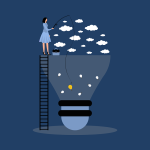
AI: how can we stay in the story?
AI: how can we stay in the story?
By
Paul Blundell
Arts organisations are facing a visibility crisis and an urgent need to build skills for AI deliverability. This includes new ways to counter the reinvention of Search Engine Optimisation. AI search is designed to keep people inside the platform, making it the destination not the gateway. The Arts Marketing Association's Head of Digital Research and Development, Paul Blundell takes us through approaches that let us adapt to the new reality.
AI search is designed to keep people inside the platform, making it the destination not the gateway. IT service management company, Cloudfare, recently revealed that 75% of queries now get answered without leaving Google – or other platforms – which has major implications for visibility of arts organisations.
Meanwhile, media company Digiday found (in August 2025) that Google AI overviews have caused a 25% drop in referral traffic while the UK Professional Publishers Association announced (also in August 2025) that it has submitted evidence and recommendations to the Competition and Markets Authority on how new AI search is harming publishers. And the Wall Street Journal, whose major sites include HuffPost, Washington Post, Business Insider, published an article last June entitled ‘News sites are getting crushed by Google’s New AI Tools’.
Evidence from the arts sector
So, when someone asks an AI assistant or agent about local exhibitions or events, your organisation may not appear in the results at all. That absence could be driving audiences, engagement and revenue elsewhere.
That’s the search traffic, but what about the agent traffic? ChatGPT’s new agent enables users to bypass websites altogether so users can ask the agent to book tickets directly with your ticketing provider, no need to visit your website.
Early sector data suggests a small decline in organic search traffic, however seasonal effects are blurring the data, so it’s too soon to confirm a downward trend.
Across the sector, organic search typically drives 38% of online sales. If that channel weakens, and we do face a significant drop in traffic, then organisations will need to adapt quickly.
Platforms are changing from distributors to destinations
The large platforms – Google, Meta, TikTok and now OpenAI and other AI companies – are reshaping the cultural narrative and becoming its gatekeepers. They are no longer neutral distributors; they can reroute attention and revenue at scale. The value (and copyright) created is now flowing into these platforms and we are being disconnected from our audiences.
To be visible, arts organisations need to be on AI’s internal map of knowledge. It’s like a vast multi-dimensional library where every cultural work, artist, theme and organisation is stored. When someone asks AI – it searches this map.
How can we stay in the story?
There are three approaches we could take:
- Secure a place on the AI map of knowledge
- Build stronger relationships with audiences to reduce reliance on intermediaries
- Collaborate with the sector to build an alternative system for ethical cultural discovery
The third option is currently out of reach because of the absence of collaboration or funding. The second can protect loyal audiences for a short time, but without AI-mediated experiences these ties may weaken, and audiences could disconnect later. But what about new audiences?
The uncomfortable truth is we have no choice but to adopt Silicon Valley’s latest business model. For many, the pragmatic approach will probably be a mix of the first two.
AI-ready data is the foundation
In 2024, UNESCO ran workshops on ethical AI use in the cultural sector. It found that getting data AI-ready must be the priority. Case studies show this potential: US agency Xponent 21 reported a 4,162% improvement in organic search visibility in a year by optimising data and content for AI. And the London Museum saw a 500% increase in visits to online collections after launching conversational AI search.
Becoming AI-ready means:
- Knowing where your data is, who controls it and what rights apply
- Ensuring your most sensitive data is protected while making it easy for AI systems to verify your public-facing content
Start small, build steadily
You don’t have to tackle everything at once; the first steps should be manageable. Focus on the data you already have to run a small defined pilot. You may want to refer to Arts Council England’s Responsible AI in Practice guide for ideas on setting up internal AI policies.
It’s also worth ensuring your board and senior management have a light-touch introduction to AI foundations and strategic implications, so there’s a shared understanding of opportunities and risks.
It’s a good idea to run a basic AI visibility check to find out how you are appearing in AI search and to see how AI agents are accessing your website. Select a high impact but small project; perhaps preparing a single event or collection for AI discovery. Involve your team from the start, to build their confidence, and so they feel part of the process.
Work on improving the metadata (for example an organisation schema on a homepage) and showing trust. AI systems look for trustworthy content and credible sources to signal this with clear organisational attribution. Strengthening these signals helps ensure your voice is recognised when AI generates answers.
Finally review the results and refine them, before scaling up for broader adoption. The important thing is to start now while there’s still time to experiment and slowly find out what works. You can then build skills and scale at a comfortable pace.
AI is already shaping how audiences find and engage with culture. If we’re not on the map we risk becoming invisible.

Paul Blundell, Head of Digital Research and Development, Arts Marketing Association
This article was originally published on the Arts Professional website. It is part of the Arts Marketing Association's editorial partnership, where we regularly contribute articles sharing ideas, innovations and resources that arts & heritage marketers and leaders need to develop their skills and inspire change.





























